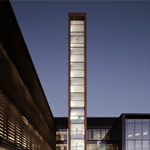This article is part of gb&d‘s Green Typologies series, City Halls: The Heart of the City.

The city hall’s clock tower is one of its few vertical features. It references Italian bell towers, given the city’s Italian Canadian heritage.
In 1960, Vaughan, Ontario, was home to just 16,000 people. In the decade between 1996 and 2006, however, the town became the fastest growing municipality in Canada and now has more than 288,000 residents. Due to its growth, in 2012 the city completed the first of three phases for its new civic center: the $108 million, 350,000-square-foot city hall, designed by Canada’s Kuwabara Payne McKenna Blumberg Architects. The building reflects the city’s agrarian roots while setting it against its new urban context by laying out the campus in east-west bands, reminiscent of the linear patterns of farming. It was certified LEED Gold last year, thanks to efficient landscaping, interconnected atria with clerestory glazing, operable windows in the upper floors, and an underground parking garage. As Vaughan continues to grow, the city hall and greater civic center will stand as a practical, sustainable centerpiece for the city.
This article is part of gb&d‘s Green Typologies series, which in each issue explores a single type of building. For more of our most recent collection, City Halls: The Heart of the City, choose from the list below:
- Las Vegas City Hall, Elkus Manfredi Architects
- River Falls, Wisconsin, City Hall, Frisbie Architects

